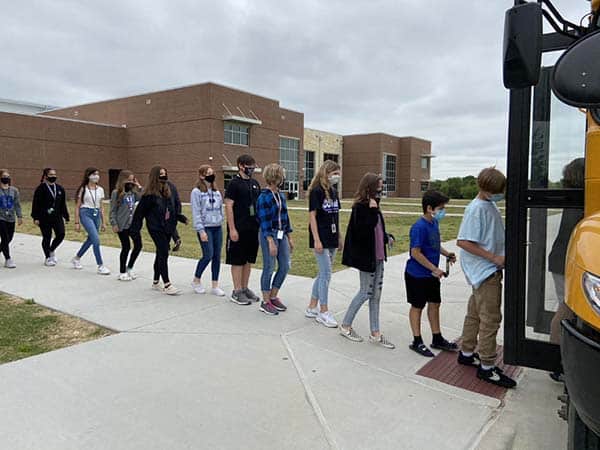Listen to this blog (6 mins)
National School Bus Driver Day is February 23, 2022. This day encourages teachers, school bus drivers, admins, and other members of the school community to address the importance of bus safety.
Each school day, nearly 472,000 school buses transport 26 million K-12 students to and from school. Their safety relies on the driver’s ability to follow safety procedures, avoid incidents, and respond well if any incidents occur.
Here are three ways K-12 schools can empower their drivers to keep students safe.
1 – Include Bus Drivers in K-12 Safety Drills
Just like others in your school community, your bus drivers must know how to keep students safe in any situation.
“An emergency is not going to discriminate based on what role you have or what task you’re trying to get done,” Dr. Jaclyn Schildkraut, the Associate Professor of Criminal Justice at the State University of New York Oswego, said while discussing why the entire school community needs to be involved in safety drills.
Let’s consider a weather-related emergency. If a tornado abruptly hits your city, your bus drivers must be able to locate shelters along their routes and safely move students from the bus into the facility.
Bus drivers also play a critical role in school evacuations by bringing students to the off-campus reunification site. In an active emergency, bus drivers must know where to park at the school, how many students they are expected to transport, what route to take to the reunification site, and what to do once at the site.

Raptor staff visited Midlothian ISD (TX) for a reunification drill. Raptor, district staff, and city staff discussed plans and what resources are available to improve emergency response. Bus drivers took part in the reunification exercise to learn their roles and responsibilities to keep students and staff safe. Watch the full video here.
The drivers—as well as the students on board—will only know these processes if they are actively practicing them through drills and building their muscle memory. They should also be encouraged to provide feedback so you can improve your emergency protocols and processes.
2 – Give Your Bus Drivers Access to Safety Technology
Let’s expand on the tornado example above. Now that the bus driver has safely evacuated students from the bus into the tornado shelter, first responders, incident commanders, and staff need to know exactly who is on board and what their conditions are. The bus driver needs a way to account for everyone and quickly relay this information back to them.
This quick communication allows first responders to know what level of response is necessary and where exactly they need to dispatch. Incident commanders and school staff must also know who is on the bus (and under the school’s care) versus which students are still at home. This information is critical for reunifying students with their guardians and providing guardians with accurate information about their child’s status and location.
School bus drivers should have access to the school’s emergency management software that enables them to account for everyone on board, text or call 911, share precise information with dispatchers, and communicate in real-time with others from wherever they are located. School staff can also use the emergency management system to alert bus drivers of emergencies. If there is a gas leak while buses are in route to school, for instance, a school admin can use the panic button to instantly send alerts to all bus drivers, letting them know to go to the off-site reunification facility instead of campus.
3 – Train Every Bus Driver to Recognize Student Crises
In a 2021 national report developed by Safe and Sound Schools and Raptor Technologies, school staff and administrators listed mental health crises, such as depression, suicide, and self-harm, as their most concerning safety threat. In the same survey, nearly 75% of students said they have experienced depression and/or anxiety from the pandemic.
“We’re seeing increasing numbers of children even under the age of 10 threatening suicide now. [These threats] must be taken seriously every single time.” Dr. Scott Poland, Professor and Co-Director of the Suicide and Violence Prevention Office, warned on an episode of School Safety Today. Dr. Poland suggested schools complete comprehensive suicide prevention training each year for their entire staff, including bus drivers.
Bus drivers are the first and last staff students interact with on a school day. Many drivers build relationships with the students, getting to know who they are, what they like and don’t like, and even who their friends are. They also see students in a more social environment while they are sitting next to their friends on the school bus.
It’s important bus drivers understand the warning signs and how to respond. If the bus driver notices a student acting differently than before or overhears a concerning conversation on the route to school, they need to know who to contact. In critical emergencies, such as suicidal behavior or threats taking place on the bus, the driver can leverage the mobile panic button system to instantly request help.
School Safety Does Not Stop at Your Property Line
And neither should your school safety technology. Raptor Emergency Management enables schools to protect their students and staff and be in complete control during drills, active incidents, and reunifications. The mobile panic button, Raptor Alert, enables any user to initiate an emergency and connect with 911 from wherever they are located, whether that be a bus driver on route to school or a football coach at an off-campus game.
To learn more, contact Raptor today to schedule a personalized demo.





